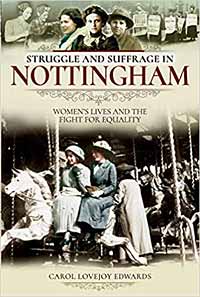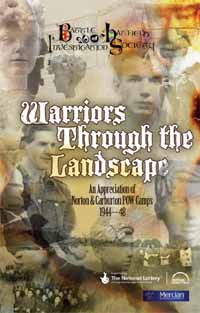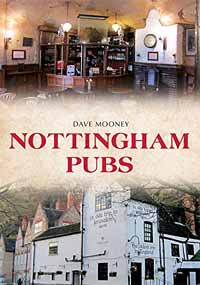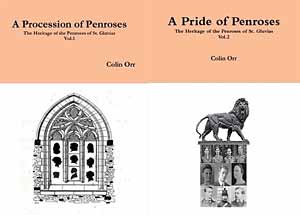Book reviews, Autumn 2019
Sgt William Henry Johnson : Victoria Cross : A Man of Moral courage and Modesty
By Robert llett
Published by Battle of Hatfield Investigation Society.
This interesting booklet is one of a series of publications produced by Bassetlaw District Council’s First World War Team. Sgt William Henry Johnson’s story is both of interest to the Historian but also gives everyone the chance to gain a very good insight into the military career and the courage those soldiers of the First World War showed. In this brief but comprehensive study, it shows the courage as a leader that Bill Johnson showed and led to him being awarded a Victoria Cross.
The booklet not only gives the history of his life from the outbreak of the War but it also explains the background to the Nottingham Territorial Regiments prior to their move to France in February 1915. Bill joined the1/8th Sherwood Foresters in 1915 and served with them for 4 years. He was with the first Territorial Division to arrive in France and the book illuminates his full Military background. A chapter entitled The Road to Victory’ which then records the Germans being pushed back to the Hindenburg Line.
The excellent short chapter called The Texture of his Courage’ allows the reader to understand Bill’s background in the Pit in his youth and shows how it helped him cope with seeing the loss of many comrades in the trenches. This insight allows the reader to develop an understanding of his character and courage, which then lead to his advance on the German Machine Gun Post, despite being wounded. The clear description of his action of destroying this Machine Gun Post and the life changing injuries he received, which then develops into his stay in hospital and his home coming are important in understanding not only how Bill, but a great many other soldiers, had long trying injuries and illness, giving them moral courage. In Bill’s case, it made him a hero.
By the time the Victoria Cross was awarded to him on December 14th 1918, Bill Johnson was convalescing in the Birmingham Hospital. He returned home to Worksop finally on 11th Feb 1919. The rest of the booklet gives a brief but important insight about bravery of the men, Bills entertainment by the King and Bill’s award of the French Medaille Militaire. It also gives the reader an insight to the functions he had to attend as a ‘hero’ and his employment and life up to his death in 1945.
The good Bibliography and Sources section will help further investigations by the reader. This booklet gives the reader an insight into the life of one soldier who became a hero. This allow the reader to understand how soldiers and their families were affected by World War 1. The Catastrophe of WW1 affected many ordinary men in Nottinghamshire and the Country. This good little booklet allows the reader to understand the way ordinary people were affected through highlighting the courage of one soldier Sgt William Henry Johnson.
Paul Baker
Struggle and Suffrage in Nottingham
By Carol Lovejoy Edwards
Published by Pen and Sword Books (ISBN: 9781526712103)

This is an enjoyable book for general interest and information, and it is an easy document to read.
I do wonder, however, what audience Carol had in mind when she wrote it: is it just intended as a general read, or is it intended for students of history or sociology, or is it intended for people searching for information on the subject? Probably a mixture of all these things, and more. The way in which the material is presented is useful, especially if one is searching for a particular topic. The subdivisions of the topics are helpful and the inclusion of dates of significant importance for each topic is a pleasing aide memoir.
There are two particular changes I would suggest: the first one would be for Carol to look again at the material to see that the details of the topics are all in the right place, without any repetition. A good example is the topic on ‘Unequal treatment and disease’, which seems out of place in the chapter where Carol placed it (pages 94-95).
Perhaps it would fit better in the chapter on health and welfare issues. Secondly, I feel that the last chapter should be divided into two. One chapter would deal with the rapid move towards universal suffrage and the way in which women became more prominent in society during the early part of the twentieth century, taking the law into their own hands in many ways. Another chapter (from about page 108 onwards) could then deal with the successful achievement of suffrage, with some thoughts about the significant part women play in society today (and perhaps even a crystal ball gaze into the future)
A further point, which I think deserves a mention, is the role of the Church during the period covered by the book. The Church of England particularly became much more involved with the needs of society during the nineteenth century, especially with providing children with basic education, as well as with women leading social work within prisons and hospitals and workhouses. Societies like the Mothers’ Union were concerned about family life and the living conditions, which many families had to endure. Societies such as the Soroptimists and the Inner Wheel were formed during the period, and together with the Women’s Institute, they encouraged female social involvement. Similarly, it is interesting that the Girl Guide movement began around 1919, thus demonstrating that it was not only boys, in the Boy Scouts, who needed preparation for the adult world; girls also needed to acquire more Self- confidence and knowledge: it was no longer just a male world! Sometimes comments made by men in Victorian times suggested that women lacked the intelligence of men and that they were incapable of doing jobs traditionally done only by men : work achieved by women during the two wars soon demolished these thoughts, and led to a compete overturning of the tables!
The photographs are good and illustrative, and the length of the book is adequate for a quick overview and it raises thought provoking issues and will encourage some readers to delve deeper into the listed bibliography - and further if desired.
Alan Langton
An Appreciation of Norton and Carburton POW Camps 1944-1948.
Published by the Battle of Hatfield Investigation Society

This is a most interesting, specialist book, revealing a wealth of information about these two Nottinghamshire POW Camps. The recent research carried out by the group has been produced by a series of very interesting and to the reader unexpected insights, through a series of chapters in the book. The first chapter by Robert llett about Norton POW Camp near Welbeck, shows how from 1944 German prisoners of War arrived at Norton Cuckney. The insight into a POW Camp in 1944 and the changes that took place in subsequent years up to 1948 is well documented with both excellent photographs to illuminate the life in the camp. This chapter takes one right up to the repatriation of German and Serbian prisoners. Robert llett goes on in the second chapter to describe more about the Carburton Camp off the Ollerton to Worksop road. Here he again uses excellent photographs from the present and the past to describe the location and life in this second camp. This once again illuminates life in the camp but also describes how Henry Faulk, a quiet Scot who outwitted Nazi bullies in this camp. The sequence of events and the arrival of prisoners from a camp in Bridgend, South Wales are developed and the sequence of events which allowed in time Henry Faulk to bring British Control to the camp.
The removal of 250 core Nazi officers from Carburton Camp to the Norton Camp in 1945, is an interesting insight to life and tensions that occurred in POW Camps. Chapters follow this by Paul Jameson on exploration of the Norton and Carburton camps in 2018, and the Testimonies of the locals who were living near the camps and who met German prisoners. These shed more understanding about life in Sherwood Forest at this time. A further chapter on Franz Egmont Seibel who was interned in Norton Camp but was allowed (because of his talents as a sculptor) to attend Mansfield Art School, gives a further insight of life from the end of the war until the final repatriations in 1948.
The obvious acceptance by the locals and the friends they made with prisoners is highlighted by the 1973 Camp Reunion, which again is well illustrated by photographs, as is the 1995 Reunion, which marked 50 years since the formation of the University of the Barbed Wire at Norton Camp. This special camp in 1945 was brainchild of the Swedish Pastor, Brigir Forell of the Y.M.C.A. that the prisoners would be better off being sent back to Germany as trained priests, teachers, youth workers and craftsmen when final repatriated. The final twenty three pages develop this with chapters by Mrs June Ibbotson on the University of the Barbed Wire, an extract from Jurgen Moltmann’s A Broad Place who traces his theologian vocation in Norton Camp and the details and photographs of the Reunion in 1995 (including the Sermon at Chuckney Church). A book I found both interesting, well researched and historically a record of conflict and friendship. I do recommend it to you all.
Paul Baker
Nottingham Pubs
By Dave Mooney
Amberley Publishing 2019 £14.99 ISBN 978 1 4456 8455 0

This is an interesting book for me, being neither a beer drinker nor a frequenter of pubs. It covers fifty pubs in Nottingham, many of which I was completely unaware, in spite of living in Nottingham all my life. There are eight chapters, the first seven each devoted to a pub crawl in a different part of the city; the last chapter relates to Kimberley. Each pub is well illustrated and for the older venues, there is a brief history. The book opens with the words and music of an ode to ‘Nottingham Ale’ with a chorus concluding
“Nottingham Ale, Boys, Nottingham Ale;
No liquor on earth like Nottingham Ale!”
Using the water that is filtered through the sandstone on which much of the city of Nottingham is built, Nottingham’s brewers have produced some of the finest beers in the country. Until relatively recently, the brewing trade in Nottingham was dominated by three giants - Shipstone’s (whose beer was known locally as ‘Shippo’s’), Kimberley Ales and Home Ales. The companies are now gone, although their former premises still stand. Nowadays, a number of micro-breweries have sprung up in their stead, often producing very different and distinctive drinks. In this book, Dave Mooney takes us on a number of short walks, taking in the sights and a range of pubs both ancient and modern.
The first is around the centre of Nottingham. The second is a history tour of the most ancient pubs - the Bell Inn, Ye Olde Salutation and the Trip to Jerusalem. He also includes the Castle, with its Watson Fothergill architecture, and, curiously, the Malt Cross on St James’ Street. We then move to Canning Circus, with the Sir John Borlase Warren, the Running Horse and a number of new pubs. Then it is down to the former village of Sneinton, calling at the Bath Inn, the Fox and Grapes and the King Billy, formerly the King William the Fourth. Mansfield Road has the Rose of England, now rather isolated following the demolition of York House, and the Peacock. Further along Mansfield Road are the Lincolnshire Poacher and various establishments in Carrington and Sherwood.
Overall, an excellent tour of Nottingham for those who like such drinking establishments.
The book is well produced and very well illustrated. My only criticism is that Dave seems to assume that the reader knows where all the pubs are. There is a rather small-scale map, but it would be useful to have had the street names.
John Wilson
A Procession of Penroses and A Pride of Penroses
ISBN 978-0-244-76302-2 Lulu Press 2019

Colin Orr has brought together archival information on the Penrose family of Cornwall in two comprehensive volumes. They were a family, which kept all kinds of papers, correspondence and family letters, and these have been thoroughly accessed by Colin to produce these books. Although the Penroses were of Cornish origin, the particular interest for Nottinghamshire is that Revd John Penrose, who followed his father into the church (also John, vicar of St Gluvias died 1776), having been rector of Perranuthnoe came north to be the incumbent of St Gregory’s, Fledborough officially in 1784. It seems he did not take up the role however until 1800. Looking at the family tree it shows that there is a lot of Nottinghamshire blood allied to the Penroses through marriages and earlier lines of descent.
The books have obviously been a labour of love for Colin - Elizabeth Cartwright, who became the wife of Revd John Penrose, is an ancestor of his wife. The Rev. John Penrose of Fledborough and Elizabeth Cartwright, later Mrs Penrose, an author known as Mrs Markham, have their own chapters in Mr Orr’s volumes.
The volumes will be offered to the University of Nottingham Manuscripts and Collections.
Members may be interested to read the history section of the Fledborough entry in the Southwell and Nottingham Church History Project for an interesting account of the Penrose family’s experiences of their time in Fledborough.
Barbara Cast